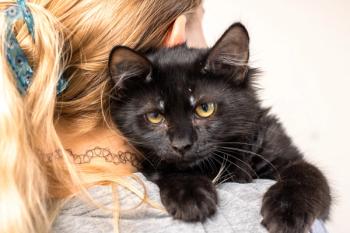
- Firstline July/August 2020
- Volume 16
- Issue 4
Your kitten foster care program needs a manual
Shelter medicine expert Dr. Amanda Dykstra makes a case for equipping foster parents with detailed instructions on the care and keeping of kittens.
You've probably heard it said that human kids don't come with instruction manuals. But according to
If you've read this
Manual matters
Dr. Dykstra's foster manual includes sections on housing, feeding, elimination and socialization. It also provides information about weight gain and milestones as well as answers to common medical concerns and what to do in case of emergency, she says.
Watch your language
Dr. Dykstra notes that because shelter veterinarians often spend less time with clients and more time talking with other veterinarians, they need to be especially cognizant of the vocabulary they use when those interactions do occur. “A lot of your foster parents won't have any medical care knowledge, so you need to make sure you're speaking to them in a way they can understand,” she says. This holds true for both written and verbal communication.
Housing
According to Dr. Dykstra, providing warmth is the most important housing concern for neonates and infants, because hypothermia has a negative impact on immunity, feeding and digestion.1 She sends foster kittens home with a safe source of heat, such as a heat lamp or a Snuggle Safe pad.
“Kittens don't regulate their own body temperature well in the first four weeks of life and can only maintain a body temperature that's about 12 degrees higher than their environment,” she explains. “This is due to their large body surface area with noncornified skin and their lack of insulating fat as well as the fact that they can't vasoconstrict their peripheral vessels. Neonates are especially susceptible because they're unable to shiver at birth.”2
Dr. Dykstra also advises foster parents to house kittens in an area that can be disinfected easily and where visits from children and other animals are restricted. “I say limited, because it's not like we don't want children to be around them at all. We want kittens to be socialized, but the interactions need to be supervised by an adult for the protection of the kitten and the child,” she says.
Feeding
Nutrition can be one of the greatest challenges for foster families, says Dr. Dyskstra. “Bottle feeding is done wrong all the time. It's amazing how often people try to bottle feed kittens like they do human babies,” she says.
Keep track of weight (and maintain your sanity)
One of the most important things you can do to set up your foster kittens for success is to send them home with a gram scale. “Weight loss is one of the most prominent indicators of illness in kittens,” says Dr. Dykstra, “so it's really, really important that your fosters are monitoring weight.”
She shares a trick for keeping track of weight without investing a lot of time: To avoid a bunch of phone calls and back-and-forth with foster parents, set up
Give foster parents the guidance they need by including specific instructions in the foster manual on preparing and warming the formula, feeding frequency, feeding positioning (it should be a 45-degree angle), weight monitoring and weaning. Dr. Dykstra also spells out signs of feeding problems as well as the risks of overfeeding, using cow's milk or mixing in too much water. “It's not uncommon for well-meaning foster parents to cause unintentional harm in an attempt to save the shelter money,” she says. “Make sure they understand how this can affect the animals in their care.”
Dr. Dykstra notes that, when available, lactating foster queens are the best option for feeding orphaned kittens as they can provide both nutrition and maternal care. “Most lactating queens will accept the additional kittens, but it's important to place foster kittens with similarly sized animals to avoid size discrepancy,”3 she says.
On the topic of weaning, Dr. Dykstra says that kittens generally start drinking formula from a dish at around 3 or 4 weeks of age and that solid food can be introduced by mixing canned food with milk replacer in a flat dish. “Slowly decrease the amount of milk replacer until the kitten is primarily eating solid food,” she explains. “By the time the kitten is 5 to 6 weeks old-and possibly sooner if the teeth are coming in well-it can chew dry food and should be eating about one-third of its daily calories in the form of solid food.”3 Kittens should be completely weaned by the time they are 6 to 9 weeks old.
Elimination
Elimination can be a major struggle for foster parents, so be sure to give them the educational (as well as material) tools they need to be successful. In kittens younger than 3 weeks old, urination and defecation must be stimulated, says Dr. Dykstra. “Normally, this is done by the queen when she licks the kitten's perineum,” she explains. “To mimic this in young orphans, foster parents need to rub the kitten's lower abdomen, genitals and rectum with a cotton ball dipped in warm water before and after each feeding.”
Explain to foster parents that kittens tend to urinate with every stimulation and defecate at least once a day, and include a poop chart in your manual so foster parents can easily keep track. “When the kitten starts eliminating on its own, it should be given a litter box with shredded paper or nonclumping litter (as kittens tend to have a taste for the clumping kind),” Dr. Dykstra says. “Stool should be placed in the litter box until the kitten learns to eliminate there.”
Socialization
The importance of the sensory phase, which begins at around 3 weeks of age and lasts until the kitten is approximately 2 months old, cannot be overstated, says Dr. Dykstra. “Opportunities to gain desirable conditioning during this time will improve the kitten's ability to be a well-socialized companion animal in the future,” she explains. “Make sure foster parents understand that their job isn't limited to keeping the kitten alive with food and water. Kittens really need frequent, careful handling.”
Emergency! (maybe)
If you'd rather not receive a desperate call at 2 a.m. about a foster kitten with a slight limp, you'll want to detail in your foster manual what constitutes an emergency (and, perhaps just as importantly, what doesn't).
Dr. Dykstra recommends having the shelter veterinarian clearly outline the clinical signs that fall into the following three categories:
- Emergency
- Needs to be examined at foster parent's convenience
- Can be watched at home.
The signs that go into each category aren't universal. “The specifics will depend on your shelter's human and material resources,” she says.
More foster kitten facts
Get tips from Dr. Dykstra on:
>
>
Make your manual count
The above represents a small smattering of what you'll need to include in your kitten foster care manual, but don't get overwhelmed by the prospect of creating your own in full. Dr. Dykstra insists there's no need to start from scratch. She's found this
Lastly, a manual is only useful if it's read, so don't just hand it to foster parents and cross your fingers that they'll crack it open when they get home. Take the time to walk through it with them so they know all of the answers it holds-whether one-on-one or during a foster orientation session.
References
1. Davidson AP. Neonatal resuscitation: improving the outcome. Vet Clin North Am Small Anim Pract 2014;44(2):191-204.
2. Thomovsky E. What to expect in a neonatal kitten or puppy, in Proceedings. North Am Vet Conf 2015;1087-1089.
3. Little S. Playing mum: successful management of orphaned kittens. J Feline Med Surg 2013;15(3):201-210.
Sarah Mouton Dowdy, a former associate content specialist for dvm360.com, is a freelance writer and editor in Kansas City, Missouri.
Articles in this issue
over 5 years ago
Make the conversation about dental health memorableover 5 years ago
Ask Emily: Do I need a monthly staff meeting?about 6 years ago
A practical review of common veterinary renal toxinsabout 6 years ago
Laser pointers can cause behavior disorders in catsabout 6 years ago
Rodeo: When patient fear makes a veterinary exam nearly impossibleabout 6 years ago
How the human-animal bond is reshaping veterinary careover 6 years ago
A primer on veterinary open wound managementalmost 7 years ago
Grief comes in many formsalmost 7 years ago
How losing a pet helped me connect with veterinary clientsNewsletter
From exam room tips to practice management insights, get trusted veterinary news delivered straight to your inbox—subscribe to dvm360.





